
Callanish (Calanais)
Isle of Lewis, Scotland
- pages by
Gerald Ponting
Isle of Lewis, Scotland
- pages by
Gerald Ponting
From here, I went north again to the smaller, but equally scenic, bay of Dalbeg. I donned walking boots and set out for Shawbost Stone Circle, on a peaty slope overlooking Loch Raoinavat. Margaret had discovered and recorded this site after we had parted company, and I had not visited it before. It was worth the hike across the windy moorland; there were two prominent erect stones and two obvious prone ones, as well as other possible features shown on the published plan.
On this trip, I was staying at a friend’s house in Carloway and I returned there briefly to pick up a spare camera battery. To my surprise, I found a message on my little-used mobile phone from Sheri Nakken of Earth Mysteries & Sacred Site Tours. I knew of this organisation through the internet; in fact I was aware that her current tour group was scheduled to have one of Margaret’s intensive Callanish tours. However, Sheri told me that this was not now going to happen … and could I do the tour?!
Now, I am a qualified tourist guide for parts of Southern England (though no longer regularly employed in this capacity), and I had often given Callanish tours back in the early 1980s, but I wondered if all the facts would come back to me. Nevertheless, I was soon sitting in the lounge of the Doune Braes Hotel, making a presentation on Callanish to a dozen American visitors. I surprised myself by my fluency and talked for nearly an hour on the subject. It was fortunate that I had brought with me a package of relevant booklets and maps, with the possibility of meeting interested people.
Following a sandwich lunch in the hotel, we all packed into their mini-bus. I gave them a guided tour, taking in not only the main Callanish site, but also the two nearby smaller circles and a burial cairn discovered (and half destroyed) by road widening in the late 1990s. I enjoyed sharing my knowledge and experiences with a really interested group of visitors.
Finally, we took the longer drive to the bridge which connects the small island of Great Bernera to the main island of Lewis. Overlooking the bridge and the narrow strait of sea is one of the strangest megalithic sites in Britain, known as Cleitir or Callanish VIII. Four tall megaliths, one of them re-erected since my time on Lewis, stand in a rough semi-circle, the diameter of which is the sheer cliff-edge overlooking the strait. A party of younger stones enthusiasts was already here before I arrived with Sheri’s group. As I gave my talk about this site, they gathered round. One of the Americans later told me that they were saying ‘Is that who I think it is?’ – and I was soon to realise that my name was well-known among megalithic enthusiasts, many of whom communicate via the Stones e-mail List and the forums on the Modern Antiquarian web-site.
They gathered round and asked their own questions; they asked me to sign copies of my 2002 book on Callanish; they asked to be photographed with me. Most memorably, a girl preparing for diving asked if she could join in the photograph and the answer was ‘No - you’re just a sexy girl in a wet-suit – this is a famous archaeo-astronomer!’ – not that I’d use that description for myself today.
Before leaving the Bernera Bridge area, we had a look at the ‘Iarsiadar Stone’, also known as ‘Callanish VIIIA’. I had known and recorded this as a single megalith, lying abandoned on a roadside verge, apparently after road widening in the 1970s. Now it stood proud and erect as a result of Margaret and Ron’s efforts. But why was it erected on the hillside, over a hundred yards from where it formerly lay?
Back at the hotel, I joined Sheri’s party for dinner; and we were also joined by John, who had caught a nice trout and had had it cooked in the hotel kitchen for his meal. I then returned to my friend’s house for a rest. I’d agreed to pick up John at 11 p.m. to return to the Stones, but as soon as I left the house, I regretted not having set out earlier. There was a superb sunset which would have made a wonderful backdrop for some atmospheric shots of the Callanish Stones, but the colour in the sky had inevitably faded by the time we reached the site.
I’d expected quite large numbers of people on this evening, one of the best dates for observing the full moon on its southern path. The movements of the moon follow a cycle of 18.6 years, so this event had last been seen in 1987 and will next occur in 2025. However, while a single date (in this case 29th September 2006) represents the time that the moon is at its very furthest south, it is almost as low in the sky at four-weekly intervals for several months on either side of this date. Only in June and July is the moon full when it is this low.
In fact, there must have been over 150 people there; with people leaving and arriving throughout the night, the total must have been greater than this. Television cameramen had set up at the east of the site, with a good view of the Sleeping Beauty across East Loch Roag. Groups sat, walked and talked among the stones as the post-sunset light slowly faded. Others were sitting on Cnoc an Tursa, the rocky hillock just to the south of the site; there they had an even finer view over the Loch. ‘Druidical’ and ‘pagan’ costumes abounded.
... ... go to next page
... ... go to next page
My Callanish Moonrise ‘blog’ -
11th-12th June 2006
Page 2 of 3
11th-12th June 2006
Page 2 of 3
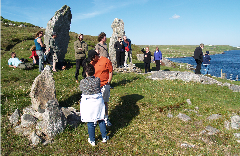
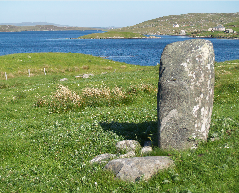
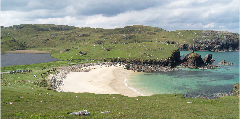

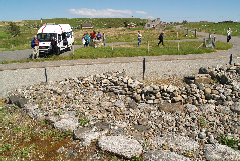
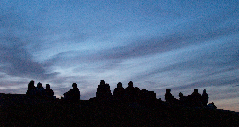
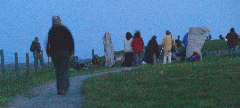
Web-site created by Gerald Ponting using Serif WebPlusX2
New page, July 2006,
tidied up, March 2009
tidied up, March 2009
All material copyright - see copyright notice
American and other enthusiasts at Cleitir ‘stone semi-circle’
The re-erected Iarsiadar Stone
American visitors at the burial cairn
Shawbost Stone Circle
Dalbeg beach
Callanish - waiting for the moon-rise: east row and Cnoc an Tursa
GO TO BLOG
PAGE 1
PAGE 1
CONTINUED ...
PLEASE NOTE : this blog dates from June 2006 and I’ve chosen to leave it as written.






